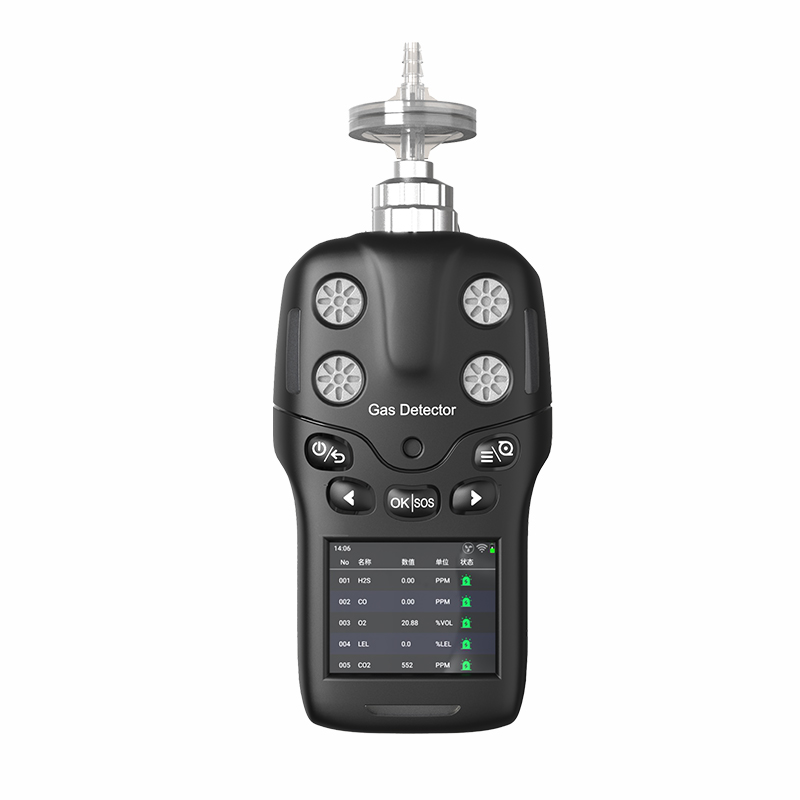- English
- Español
- Português
- русский
- Français
- 日本語
- Deutsch
- tiếng Việt
- Italiano
- Nederlands
- ภาษาไทย
- Polski
- 한국어
- Svenska
- magyar
- Malay
- বাংলা ভাষার
- Dansk
- Suomi
- हिन्दी
- Pilipino
- Türkçe
- Gaeilge
- العربية
- Indonesia
- Norsk
- تمل
- český
- ελληνικά
- український
- Javanese
- فارسی
- தமிழ்
- తెలుగు
- नेपाली
- Burmese
- български
- ລາວ
- Latine
- Қазақша
- Euskal
- Azərbaycan
- Slovenský jazyk
- Македонски
- Lietuvos
- Eesti Keel
- Română
- Slovenski
- मराठी
- Srpski језик
How can a four-in-one gas detector accurately detect poison in confined space operations?
2025-04-02
In confined space operations, due to the relatively closed space and poor ventilation, there is often a risk of accumulation of various toxic and harmful gases. These gases may not only pose a serious threat to the health of operators, but may also cause serious accidents such as fires and explosions. Therefore, it is particularly important to ensure the safety of confined space operations and accurately detect toxic and harmful gases. As an efficient and convenient detection tool, the four-in-one gas detector plays a vital role in confined space operations with its multiple gas detection capabilities, high sensitivity and high precision, fast response, portability and durability. In this article, the editor of Zechuan Technology will introduce in detail how the four-in-one gas detector can accurately detect poisons in confined space operations to ensure the life safety of operators.
The following is a detailed answer to this question:
Performance characteristics of the four-in-one gas detector
1. Multiple gas detection capabilities:
The four-in-one gas detector can simultaneously detect four common toxic and harmful gases in confined spaces, such as oxygen (O₂), combustible gas (EX), carbon monoxide (CO) and hydrogen sulfide (H₂S). This multi-gas detection capability can fully cover the potential safety hazards in confined spaces.
2. High sensitivity and high precision:
Advanced sensor technology makes the four-in-one gas detector extremely sensitive and accurate. They can accurately capture small changes in gas concentration and sound an alarm even at low concentrations, ensuring that operators can take safety measures in time.
3. Quick response:
The four-in-one gas detector has a very fast response speed, which can detect changes in gas concentration in a short time and sound an alarm immediately. This is crucial for confined space operations, as any delay may lead to serious accidents.
4. Portability and durability:
Four-in-one gas detectors are usually designed to be small and lightweight, easy to carry and operate. At the same time, they also have a rugged and durable shell and protection level, which can maintain stable performance in harsh working environments.
Correct usage method
1. Preparation before starting:
Make sure that the gas detector is within the validity period of verification/calibration and has obtained the corresponding certificate of conformity.
Check whether the battery is fully charged, whether the appearance is clean and undamaged, and whether the air inlet and sensor components are unobstructed.
Confirm the connection of the extended sampling tube and the filter device to ensure that there is no leakage or blockage.
2. Power-on preheating and calibration:
Turn on the power of the gas detector and preheat it to make the sensor reach a stable working state.
If it is used for the first time or has not been used for a long time, it is necessary to use standard gas for calibration to ensure the accuracy of the test results.
3. Set the alarm threshold:
Set a reasonable alarm threshold according to the safety requirements of confined space operations. When the gas concentration exceeds the threshold, the detector will sound an alarm to remind the operator to take timely measures.
4. On-site detection:
Before entering the confined space, use the gas detector to detect the gas concentration in the space. The detector should be moved slowly during the detection to ensure that the entire space is covered.
If the concentration of harmful gases exceeds the standard or the oxygen content is insufficient, the confined space should be evacuated immediately and the relevant personnel should be notified for processing.
5. Data recording and analysis:
The four-in-one gas detector usually has a data recording function, which can record the changes in gas concentration during the detection process. These data are of great significance for subsequent safety analysis and accident investigation.
Matters Needing Attention
1. Regular Calibration and Maintenance:
The four-in-one gas detector needs to be calibrated regularly to ensure its accuracy and reliability. At the same time, the detector should also be maintained regularly, such as cleaning the sensor window, replacing damaged parts, etc.
2. Correct Use and Wearing:
When using the gas detector, make sure that its back clip is intact to avoid accidental drop and damage to the instrument after wearing. At the same time, the detector should be worn close to the mouth and nose breathing area so that harmful gases can be detected in time.
3. Training and Drills:
Training on the use of gas detectors should be conducted for workers in confined spaces to ensure that they can operate and maintain the detectors correctly. At the same time, emergency drills should be conducted regularly to improve the workers' ability to respond in emergency situations.
In summary, the ability of the four-in-one gas detector to accurately detect poisons in confined space operations is crucial to ensuring the life safety of workers. By reasonably selecting and using gas detectors, we can promptly detect and warn of toxic and harmful gases in confined spaces, thereby taking effective measures to avoid accidents. At the same time, we should also fully understand the limitations and precautions of gas detectors, and regularly calibrate and maintain them to ensure that they are always in good working condition. Only in this way can we make better use of the four-in-one gas detector as a powerful tool to provide strong protection for the safety of confined space operations.








